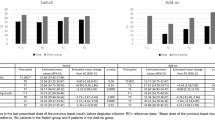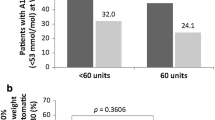Abstract
BACKGROUND
Patients and providers may be reluctant to escalate to insulin therapy despite inadequate glycemic control.
OBJECTIVES
To determine the proportion of patients attaining and maintaining glycemic targets after initiating sulfonylurea and metformin oral combination therapy (SU/MET); to assess insulin initiation among patients failing SU/MET; and to estimate the glycemic burden incurred, stratified by whether HbA1c goal was attained and maintained.
DESIGN
Longitudinal observational cohort study.
SUBJECTS
Type 2 diabetes patients, 3,891, who newly initiated SU/MET between 1 January 1996 and 31 December 2000.
MEASUREMENTS
Subjects were followed until insulin was added, health plan disenrolment, or until 31 December 2005. We calculated the number of months subjects continued SU/MET therapy alone, in total, and during periods of inadequate glycemic control; the A1C reached during those time periods; and total glycemic burden, defined as the estimated cumulative monthly difference between measured A1C and 8%.
RESULTS
During a mean follow-up of 54.6 ± 28.6 months, 41.9% of the subjects added insulin, and 11.8% received maximal doses of both oral agents. Over half of SU/MET patients attained but failed to maintain A1C of 8%, yet continued SU/MET therapy for an average of nearly 3 years, sustaining glycemic burden equivalent to nearly 32 months of A1C levels of 9%. Another 18% of patients never attained the 8% goal with SU/MET, yet continued that therapy for an average of 30 months, reaching mean A1C levels of 10%.
CONCLUSIONS
Despite inadequate glycemic control, a minority of patients added insulin or maximized oral agent doses, thus, incurring substantial glycemic burden on SU/MET. Additional studies are needed to examine the benefits of rapid titration to maximum doses and earlier initiation of insulin therapy.

Similar content being viewed by others
References
UKPDS Group. Glycemic control with diet, sulphonylurea, metformin, or insulin in patients with type 2 diabetes mellitus: progressive requirement for multiple therapies (UKPDS 49). JAMA. 1999;281:2005–12.
Diabetes Control and Complications Trial Research Group. The effect of intensive treatment of diabetes on the development and progression of long-term complications in insulin-dependent diabetes mellitus. N Engl J Med. 1993;329:977–86.
UKPDS Group. UKPDS 33: Intensive blood-glucose control with sulphonylureas or insulin compared with conventional treatment and risk of complications in patients with Type 2 diabetes. Lancet. 1998;352:837–51.
UKPDS Group. UKPDS 34: Effect of intensive blood-glucose control with metformin on complications on overweight patients with type 2 diabetes. Lancet. 1998;352:854–65.
Boccuzzi SJ, Wogen J, Fox J, Sung JCY, Shah AB, Kim J. Utilization of oral antihyperglycemic agents in a drug-insured US population. Diabetes Care. 2001;24:1411–15.
Brown JB, Nichols GA. Slow response to loss of glycemic control in type 2 diabetes mellitus. Am J Manag Care. 2003;9:213–17.
Cook MN, Girman CJ, Stein PP, Alexander CM, Holman RR. Glycemic control continues to deteriorate after sulfonylureas are added to metformin among patients with type 2 diabetes. Diabetes Care. 2005;28:995–1000.
De Witt DE, Hirsch IB. Outpatient insulin therapy in type 1 and type 2 diabetes mellitus: a scientific review. JAMA. 2003;289:2254–64.
Nathan DM, Buse JB, Davidson MB, et al. Management of hyperglycemia in type 2 diabetes: a consensus algorithm for the initiation and adjustment of therapy. Diabetes Care. 2006;29:1963–72.
Shah BR, Hux JE, Laupacis A, Zinman B, van Walraven C. Clinical inertia in response to inadequate glycemic control: do specialists differ from primary care physicians? Diabetes Care. 2005;28:600–06.
Grant RW, Cagliero E, Dubey AK, et al. Clinical inertia in the management of type 2 diabetes metabolic risk factors. Diabet Med. 2004;21:150–5.
Grant RW, Buse JB, Meigs JB, The University HealthSystem Consortium (UHC) Diabetes Benchmarking Project Team. Quality of diabetes care in U.S. academic medical centers. Diabetes Care. 2005;28:337–42.
Polonsky WH, Fisher L, Guzman S, Villa-Caballero L, Edelman SV. Psychological insulin resistance in patients with type 2 diabetes: the scope of the problem. Diabetes Care. 2005;28:2543–5.
Peyrot M, Rubin RR, Lauritzen T, et al. Resistance to insulin therapy among patients and providers: results of the cross-national Diabetes Attitudes, Wishes, and Needs (DAWN) study. Diabetes Care. 2005;28:2673–9.
Brown JB, Nichols GA, Perry A. The burden of treatment failure in type 2 diabetes. Diabetes Care. 2004;27:1535–40.
Hertz RP, Unger AN, Lustik MB. Adherence with pharmacotherapy for type 2 diabetes: a retrospective cohort study of adults with employer-sponsored health insurance. Clin Ther. 2005;27:1064–73.
Steiner JF, Prochazka AV. The assessment of refill compliance using pharmacy records: methods, validity, and applications. J Clin Epidemiol. 1997;50:105–16.
American Diabetes Association. Standards of medical care for patients with diabetes mellitus; clinical practice recommendations 2006. Diabetes Care. 2006;29:S1–S85.
Stratton IM, Alder AI, Neil HAW, Matthews DR, Manley SE, Cull CA, Hadden D, Turner RC, Holman RR, and on behalf of the UKPDS Study Group. UKPDS 35: association of glycaemia with macrovascular and microvascular complications of type 2 diabetes (UKPDS 35): prospective observational study. BMJ 8-12-2000;21[7258], 405–12.
Leslie CA, Satin-Rapaport W, Matheson D, Stone R, Enfield G. Psychological insulin resistance: a missed diagnosis? Diabetes Spectr. 1994;7:52–7.
Rubin R, Peyrot M. Psychological issues and treatments in people with diabetes. J Clin Psychol. 2001;57:457–78.
Koerbel G, Korytkowski M. Insulin therapy resistance: another form of insulin resistance in type 2 diabetes. Pract Diabetol. 2003;22:36–40.
Peyrot M. Psychological insulin resistance: overcoming barriers to insulin therapy. Pract Diabetol. 2004;23:6–12.
Polonsky WH, Jackson RA. What’s so tough about taking insulin? Addressing the problem of psychological insulin resistance in type 2 diabetes. Clin Diabetes. 2004;22:147–50.
Nichols GA, Alexander CM, Girman CJ, Kamal-Bahl S, Brown JB. Treatment escalation and rise in HbA1c following successful initial Metformin therapy. Diabetes Care. 2006;29:504–9.
Nichols GA, Alexander CM, Girman CJ, Kamal-Bahl S, Brown JB. A contemporary analysis of secondary failure of successful sulfonylurea therapy. Endocr Pract. 2006; (in press).
Brown JB, Nichols GA, Glauber HS. Case-control study of 10 years of comprehensive diabetes care. West J Med. 2000;172:85–90.
Nichols GA, Glauber HS, Javor K, Brown JB. Achieving further glycemic control in type 2 diabetes mellitus. West J Med. 2000;173:5–9.
Willey CJ, Andrade SE, Cohen J, Fuller JC, Gurwitz JH. Polypharmacy with oral antidiabetic agents: an indicator of poor glycemic control. Am J Manag Care. 2006;12:435–440.
Acknowledgments
The authors wish to thank Jennifer Coury, for her editing suggestions, and James Hartnett, for his helpful review and comments. This work was supported by funding from Pfizer, Inc. and by the Kaiser Permanente Center for Health Research.
Conflict of Interest Statement
Within the past 3 years, Gregory A. Nichols has received grant support from Pfizer, Inc.; GlaxoSmithKline, Inc; Merck & Co., Inc.; Eli Lilly and Co.; Sanofi-Aventis; and Bristol-Myers Squibb. Sonali N. Shah and Yuri Koo are employed by and hold stock in Pfizer, Inc.
Author information
Authors and Affiliations
Corresponding author
Additional information
Supported by a research grant from Pfizer, Inc.
Presented in poster form at the American Diabetes Association 66th Annual Meetings, June, 2006.
Rights and permissions
About this article
Cite this article
Nichols, G.A., Koo, Y.H. & Shah, S.N. Delay Of Insulin Addition To Oral Combination Therapy Despite Inadequate Glycemic Control. J GEN INTERN MED 22, 453–458 (2007). https://doi.org/10.1007/s11606-007-0139-y
Published:
Issue Date:
DOI: https://doi.org/10.1007/s11606-007-0139-y




